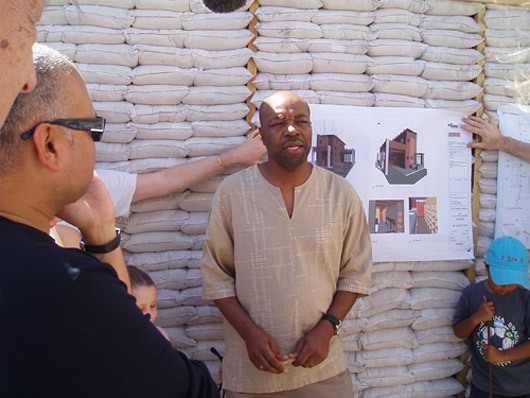Curry Stone Design Prize Announces Five Finalists
By Bustler Editors|
Wednesday, Aug 27, 2008
Related

Lexington, KY, August 26, 2008—An architectural firm that builds homes from sandbags in the shantytowns of Cape Town, South Africa, the young inventor of the world’s first non-turbine wind-powered generator, and an Indiana-based university professor who builds shelters using scavenged materials are among the five finalists for the inaugural Curry Stone Design Prize. The winner will be announced Sept. 25, 2008 at the IdeaFestival in Louisville, KY.
The Curry Stone Design Prize, administered by the University of Kentucky College of Design, is awarded every year to breakthrough design solutions with the power and potential to improve our lives and the world we live in. Jurors for this year’s prize are journalist John Hockenberry, internationally acclaimed architect David Adjaye, designer Renny Ramakers; prize founder Clifford Curry; and Michael Speaks, international design scholar and dean of University of Kentucky’s College of Design.
“The prize finalists selected this year personify the spirit of ingenuity and resourcefulness that designers can bring to solving the world’s most formidable challenges,” said David Mohney, Prize Secretary and Curry Stone Chair in Design at the University of Kentucky. The prize winner receives an award of $100,000; up to four finalists receive $10,000 each. Finalists are selected from a pool of nominees submitted by leaders from the architecture and design communities.
The prize finalists, who will be officially unveiled on Sept. 13, 2008 at the 11th International Venice Architecture Biennale are:
Shawn Frayne, 27, inventor of the Windbelt, the world’s first non-turbine wind-powered generator. The technology, which is light enough to hold in your hand, has enormous potential to help people in poor communities power lamps, run small vaccine refrigerators and charge cell phones for pennies a day. Frayne was inspired to create the Windbelt after a visit to a village in Haiti where residents rely on costly kerosene and diesel for lack of an electrical grid.

Shawn Frayne demonstrates how the Windbelt can light WLEDs.
Wes Janz, 55, architect and associate professor of architecture at Ball State University in Indiana and author of the forthcoming book, “One Small Project.” Janz’s practice focuses on “leftover places” – the world’s slums and settlements where people build shelters from scavenged materials – as sites of innovation and inspiration for architects committed to using their craft for social good. In collaboration with his students and local communities, Janz has constructed shelters and pavilions in Argentina, Sri Lanka and elsewhere from found materials such as mud and rubble from demolished buildings.

Wes Janz: “One person. One architect. One small project. Repeat.”
MMA Architects, whose principals, Luyanda Mpahlwa, 49, and Mphethi Morojele 45, are reshaping South Africa’s post-apartheid architectural landscape. MMA’s innovations include an ingenious design for low-cost homes in a shantytown outside Cape Town, with timber frame and sandbag infill construction that can be built for $6,900. The design, which borrows from indigenous mud-and-wattle building techniques, is energy efficient and requires little to no electricity or skilled labor to construct. MMA will complete 10 such houses by the end of the year with volunteer help from local women in the community.

Luyanda Mpahlwa explains the design of his 10×10 house.
Marjetica PotrÄ, 55, an artist and architect who works closely with impoverished communities to devise sustainable solutions to quality-of-life dilemmas. A six-month stay in the barrios of Caracas, Venezuela, resulted in her design for a “dry toilet” which collects human waste and converts it to fertilizer. More recently, she has spent time in New Orleans examining the revival of homegrown sustainable practices such as rainwater harvesting, which helps collect storm water runoff, restores wetlands and prevents flooding.

Marjetica Potrđs Caracas:House with Extended Territory, 2003, building material, power and communications infrastructure.
Antonio Scarponi, 34, an architect based in Venice, Italy whose interdisciplinary projects use architecture, multimedia arts and design to “jam” conventional social orders and illuminate the social and political lines that unite and divide us. His 2007 interactive project, “Dreaming Wall,” was a digitally generated billboard installed in an historic Milanese square that displayed randomly chosen real-time text messages sent from across the world.

Antonio Scarponi’s Dreaming Wall is a tool of cultural, simultaneous and random collective communication.
“The Curry Stone Design Prize rewards and encourages innovative uses of design to transform the everyday lives of people in Kentucky and around the world,” said Michael Speaks, dean of the College of Design. “The idea is to reward great design – urban design, architecture, graphic and product design – but also, and perhaps more importantly, to expand the very notion of design itself. Design is a means of acting in and transforming the world and the Curry Stone Design Prize rewards design that does just that.”
About the Curry Stone Design Prize
The Curry Stone Design Prize recognizes exceptional designers based on individual merit and the potential to bring their ideas to fruition. The prize focuses on emerging design ideas that contribute to the vitality of the world community. These designs may improve the human spirit, increase awareness of the environment, or respond to an area of need, whether to provide shelter and clean water or address climate change and humanitarian crises. The prize is part of a $5.5 million gift to the University of Kentucky College of Design from alumnus Clifford Curry and his wife H. Delight Stone of Oregon. As the principal architect for William Colson, Curry helped pioneer modern-day retirement developments as affordable and livable communities.

Share
0 Comments
Comment as :